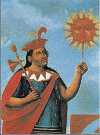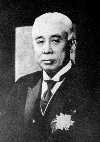 Known as “The March King,” Sousa was an American bandmaster who composed more than 130 military marches, including “The Stars and Stripes Forever” and “Semper Fidelis”—the official march of the US Marines. In 1868, when Sousa was 13, his father enlisted him in the Marine Corps as an apprentice in the Marine Band, which he later led from 1880 until 1892, at which point he formed his own band and toured to great acclaim. In the 1890s, Sousa developed a type of bass tuba now known as what? Discuss
Known as “The March King,” Sousa was an American bandmaster who composed more than 130 military marches, including “The Stars and Stripes Forever” and “Semper Fidelis”—the official march of the US Marines. In 1868, when Sousa was 13, his father enlisted him in the Marine Corps as an apprentice in the Marine Band, which he later led from 1880 until 1892, at which point he formed his own band and toured to great acclaim. In the 1890s, Sousa developed a type of bass tuba now known as what? Discuss
Source: The Free Dictionary
 In 1954, John C. Lilly developed the isolation tank to test the effects of sensory deprivation. Such tanks are intended to completely deprive the brain of any external stimulation; they are lightless, soundproof, and filled with warm saltwater to promote flotation and reduce skin sensation. Isolation tanks are now used for meditation, relaxation, and in alternative medicine. A therapeutic session typically lasts an hour, and it is reportedly common to experience what during the first 40 minutes?
In 1954, John C. Lilly developed the isolation tank to test the effects of sensory deprivation. Such tanks are intended to completely deprive the brain of any external stimulation; they are lightless, soundproof, and filled with warm saltwater to promote flotation and reduce skin sensation. Isolation tanks are now used for meditation, relaxation, and in alternative medicine. A therapeutic session typically lasts an hour, and it is reportedly common to experience what during the first 40 minutes?  The Mughal empire was a Muslim imperial power that ruled most of the Asian subcontinent between the 16th and 19th centuries. Led by Babur, the dynasty’s founder, Mughal forces made an inroad into India in 1526, occupying Delhi in the first Battle of Panipat. Babur was succeeded by his son, who soon lost the empire to the Afghan Sher Khan. In 1556, Babur’s grandson came to power and defeated the army of Hemu in the Second Battle of Panipat. What became of Hemu?
The Mughal empire was a Muslim imperial power that ruled most of the Asian subcontinent between the 16th and 19th centuries. Led by Babur, the dynasty’s founder, Mughal forces made an inroad into India in 1526, occupying Delhi in the first Battle of Panipat. Babur was succeeded by his son, who soon lost the empire to the Afghan Sher Khan. In 1556, Babur’s grandson came to power and defeated the army of Hemu in the Second Battle of Panipat. What became of Hemu?  Each year a festival takes place in
Each year a festival takes place in  A former fruit picker and cowboy, the guitar-strumming Rogers—born Leonard Franklin Slye—began his musical career in the 1930s as a radio performer. He later founded the Sons of the Pioneers, a singing trio that began appearing in movies in 1935, and soon succeeded Gene Autry as America’s favorite singing cowboy in movies of the mid-1940s. Rogers appeared in dozens of B movies with his wife, Dale Evans, and his famous horse, Trigger. What was the theme song of their television program?
A former fruit picker and cowboy, the guitar-strumming Rogers—born Leonard Franklin Slye—began his musical career in the 1930s as a radio performer. He later founded the Sons of the Pioneers, a singing trio that began appearing in movies in 1935, and soon succeeded Gene Autry as America’s favorite singing cowboy in movies of the mid-1940s. Rogers appeared in dozens of B movies with his wife, Dale Evans, and his famous horse, Trigger. What was the theme song of their television program?  After Joseph Smith, Jr., founder of the Church of Jesus Christ of the Latter-day Saints, and his Mormon followers were forced to flee Missouri in 1839, they established a new community in Nauvoo, Illinois. They soon set to building a grandiose temple, but construction was only half complete when Smith was assassinated in 1844. Two years later, the Mormons were driven from that city as well. They tried to sell their temple for $200,000, but it ultimately sold for what greatly reduced price?
After Joseph Smith, Jr., founder of the Church of Jesus Christ of the Latter-day Saints, and his Mormon followers were forced to flee Missouri in 1839, they established a new community in Nauvoo, Illinois. They soon set to building a grandiose temple, but construction was only half complete when Smith was assassinated in 1844. Two years later, the Mormons were driven from that city as well. They tried to sell their temple for $200,000, but it ultimately sold for what greatly reduced price?  Cofounder of one of Japan’s first political parties, Hara served as prime minister of Japan from 1918 to 1921, becoming the first commoner to be appointed to that office. During that time, he suppressed labor organization while extending suffrage to small landholders by lowering the property qualifications for voting. Hara also attempted to reduce the power of the military, which led to his assassination by a fanatic. Which of his possessions did he describe as his most valuable in his will?
Cofounder of one of Japan’s first political parties, Hara served as prime minister of Japan from 1918 to 1921, becoming the first commoner to be appointed to that office. During that time, he suppressed labor organization while extending suffrage to small landholders by lowering the property qualifications for voting. Hara also attempted to reduce the power of the military, which led to his assassination by a fanatic. Which of his possessions did he describe as his most valuable in his will?  The idea of letting children have a “
The idea of letting children have a “